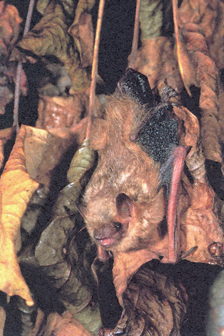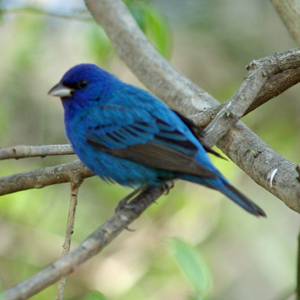Bats of Iowa
Vespertilionidae
Pipistrellus subflavus (F. Cuvier)
Eastern Pipistrelle

Etymology
Italian: Pipistrellus-"bat."
Latin: subflavus -"yellow belly."
Appearance
Fur: Yellowish or grayish brown; hair-dark gray base, broad
yellowish-brown subterminal band, dark brown tip.
Tail membrane: Basal one-third sparsely furred; darker toward tip.
Wing membrane: Blackish, usually contrasting with reddish forearm.
Calcar: Not keeled.
Ears: Tannish; hairless; rounded at tips.
Tragus: Less than one-half ear length; bluntly rounded; curved
forward.
Total length: 81-89 mm. Forearm: 31-35 mm. Wingspan: 208-258 mm.
Total weight: 4-8 g.
Dental formula: 34 total; I 2/3, C 1/1, P 2/2, M 3/3.
Confusing Species
All species of Myotis are brown in color, but do not have reddish
forearms that distinctly contrast with dark wing membrane like the
Pipistrelle.
Distribution and Status
Overall: Eastern United States; west to central Kansas and south to
Yucatan, Mexico.
Iowa: Probably statewide, but not reported from the northwestern
corner. Most common in eastern counties, local elsewhere; present all
year.
Natural History
Perhaps less is known about the eastern pipistrelle in Iowa than any
other bat species. Available evidence suggests that both males and
females are common in eastern Iowa throughout the year where there
are both forested limestone outcroppings as well as forests and
wooded waterways. Pipistrelles seasonally migrate to and from
central and western counties, utilizing small caves enroute. All
winter records for this species are from eastern Iowa, where it is a
common hibernator in humid sections of caves and mines, usually
hanging singly but near the big and little brown bats and the
northern myotis. Copulation occurs in fall and winter at or near
their hibernacula.
In summer, adults of both sexes inhabit water courses bordered by
deciduous woods and roost in crevices, caves, and buildings. Females
establish nursery colonies in a variety of these sites, and produce
one or two young. Males and nonreproductive females usually roost
away from nurseries. In Iowa, young are born by late June and begin
flying by mid-July. Eastern pipistrelles emerge early in the
evening, foraging for a variety of insects including leafhoppers,
beetles, flies, moths and true bugs.
As with most bats of Iowa, the eastern pipistrelle requires forested
habitat, especially along streams. Since it also utilizes caves and
mines for both summer roosting and winter hibernation, both types of
habitats need protection.

.jpg)
